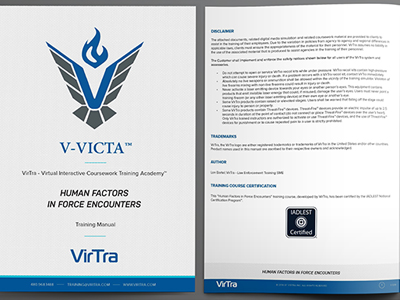Human Factors Training in Use of Force Encounters
Officers Learn How Human Nature Affects Policing
Currently, there is a concerned societal focus on police use of force encounters. These events are captured on law enforcement body cameras and citizen’s cell phones, then quickly distributed worldwide. Viewing any type of violence is difficult to watch—regardless of the circumstance—and prompts a “call to action” that leaves many people saying that something needs to be done. To properly learn from and prepare for these difficult events, officers need to know the human factors that critically influence how events play out. Even individuals who have been on the field for a while can benefit from human factors training. Having this information taught in realistic human factors training scenarios could potentially change future, similar events and create a better outcome for all.
VirTra’s “Human Factors in Force Encounters” curriculum accomplishes this through research-backed, nationally-certified training lessons. The dynamic combination of well-rounded classroom presentations and realistic video scenarios teaches and demonstrates various human factors concepts. The curriculum lays the foundation, whereas the corresponding scenario allows officers to fully experience and understand the science behind humanity—especially why certain situations may trigger certain responses. Knowing human factors allows officers to better control the situation, and ultimately, the outcome. This training is also applicable to individuals who need to brush up on their skills, which is why our simulations are versatile enough for continuation training. This human factors training curriculum’s immersive, gripping experience also provides an insight to citizens, police leaders and instructors, community leaders and lawmakers.

Influencing Police Training
How Instructors Can Easily Incorporate V-VICTA® into Human Factors Training & Continuation Training
Human Factors in Use of Force Encounters is nationally-certified and is designed to be used with VirTra’s science-based simulators for the best learning. Instructors receive 7 human factors training hours through: an in-depth lesson plan, a PowerPoint presentation, class evaluation forms, tests, corresponding realistic video scenarios and more. These assets work in tandem to teach how the brain collects, processes and uses information—then takes it a step further to show how the body utilizes that information and which factors are influential. For example, stress is something that affects everyone.
Starting in the academy, officers are taught stress inoculation, though it is a difficult lesson and one that always needs improving, such as through human factors training. This is because stress:
• Increases heart and breathing rate
• Increases muscle tension
• Narrows a person’s attentional process (their ability to observe and analyze)
Each of these effects are natural, but can become a hinderance in the field. As such, officers who know how stress affects them can learn to recognize it and minimize its negative effects. In addition to stress, this curriculum covers other human behaviors, all with the purpose to show reaction and response time, how memory effects the ability to recall details, schema and how to make better decisions with minimal time.
A Sneak Peek into Human Factors Training
See How Scenarios Work and Branch During Training
One of the most powerful scenarios within this curriculum is “Shoot and Turn.” How it works is simple: trainees begin by facing the simulator. Then, the instructor fires up the scenario, which pulls up a threatening-looking subject. From here, the real training begins, as officers can practice verbal communication, less lethal, commands, etc. Depending on the officer’s actions, the instructor can choose for the scenario to branch—having the subject shoot and run, surrender, etc. No matter your agency’s protocol in these types of situations, there are options built into each scenario to allow you to train your officers as protocols require. This allows you to also conduct human factors training effectively, as you can adjust scenarios to provide unique experiences for your officers so that they do not become complacent. This is a perfect method of teaching in a safe environment, providing all trainees the same training experience, all while showing officers the consequences of their actions and creating room for discussions after.
Watch “Shoot and Turn” below, which highlights how quickly officers must make decisions. How quickly would your officers react? Did you even notice the gun in the subject’s hand or how he was running towards a playground full of children? The data that appears after the scenario is complete adds further understanding of human factors. For example, in the video above, the numbers show exactly how much time passed between the subject’s actions and the officer’s response. This makes the curriculum a fantastic teaching tool for both your department and community.
Nationally Certified Officer Curriculum
Certified Curriculum Ensures Best Human Factors Training & Skill Transfer
Curriculum can be the difference between a good officer and a great officer. To ease the instructor’s workload while simultaneously providing the best training materials, VirTra went through the effort of having our Human Factors in Use of Force Encounters curriculum nationally-certified through IADLEST. IADLEST’s National Certification Program sets the POST training standard for 36+ states and works to improve training nationwide. By having human factors both POST approved and nationally-certified, departments automatically receive the training hours when the curriculum is taught. Whether our human factors continuation training curriculum will be used to help veterans brush up on their skills or teach trainees the foundation, this V-VICTA® curriculum effectively prepares law enforcement members for potentially dangerous events.
V-VICTA®—VirTra’s Virtual Interactive Coursework Training Academy—oversees all nationally-certified curriculum, including human factors. Other certified curricula within the V-VICTA program include: High Risk Vehicle Stops, De-Escalation, Mental Illness: A Practical Approach, and more. All V-VICTA curriculum is free with every law enforcement simulator, saving departments ample man-hours and thousands of dollars. To learn more about Human Factors Training and V-VICTA curriculum, contact a VirTra specialist.







